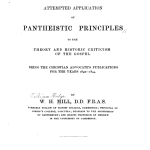 Welcome to the Friday Book Corner. Today’s book is the second edition of Paul, Apostle of Liberty by Richard N Longenecker (Eerdmans, 2015).
Welcome to the Friday Book Corner. Today’s book is the second edition of Paul, Apostle of Liberty by Richard N Longenecker (Eerdmans, 2015).
Truth be told, I have a reprinted 1976 edition of this book on my bookshelf (original, 1964), never read (it was bequeathed to me). Don’t get me wrong. I have long admired Dr. Longenecker’s work. I enjoyed his Introducing Romans (2011). I regularly return to Biblical Exegesis in the Apostolic Period. He was the master of edited volumes, such as Community Formation in the Early Church and the Church Today (2002), and Contours of Christology in the New Testament (2005) –perhaps my favorite is The Road from Damascus (1997) – I have used that as a textbook in the past. And of course there are his commentaries – I cut my teeth on the study of Acts with his Expositor’s commentary.
The second edition of Paul, Apostle of Liberty, has given me a chance to sit down and read this study of the “origin and nature of Paul’s Christianity” (as the original subtitle read). Before I comment on the subject matter (apparently largely unchanged from the original), I want to note what has been added to this second edition.
Foreword – Douglas Campbell has written a lengthy and rewarding foreword that encourages the reader to return to this classic to reflect on Pauline scholarship of the last half-century or so. In his own words, Campbell claims “ what we find in Paul, Apostle of Liberty is an evangelical analysis of Paul, responsive to all the Jewish questions that Sanders later responded to, but developed in a far more constructive way and many years in advance of Sanders’ key work” (xvi). This provides a strong precedent for evangelicals taking some of the NPP seriously. Truth be told, Longenecker is quite critical of the NPP as a movement, but Campbell is right to note that Longenecker was already anticipating some of Sanders’ insights by underscoring a distinction between legalism and nomism in “predestruction Hebraic Judaism” (see 77).
2015 Addendum: The original piece that Longenecker adds to this book is an appended chapter: “Understanding Paul and His Letters during the Past Twenty Centuries, with Particular Attention to His Letter to the Christians in Rome.” 20 CENTURIES – wow! That’s quite an undertaking, and of course the essay is long, over 100 pages. Obviously Longenecker could not be exhaustive, but extremely insightful and he comments on the NPP as well as the trend to study narrative dynamics in Paul. The addendum feels a bit wedged into the book, but I am happy to have a second edition, rather than no second edition. Also, the addendum would make good reading all on its own as an essay assigned for students to read about history of interpretation.
The Book Itself: I think the title is a bit misleading – it could lead some to think Paul was libertine, which he was not (Longenecker tips his hat at this concern p. 142). Longenecker emphasizes continuity with the OT (promise/fulfillment) rather than legalism/freedom. I think the core of the book is expressed quite explicitly in chapter 6: “At the heart of the Apostle’s teaching is his convinction that the Law in its contractual aspect—and that means especially Jewish nomism—has come to its full completion and terminus in Christ” (116). This does not mean the Law is disregarded; Longenecker sees Paul as recognizing its impact “as the standard and judgment of God” (134). Longenecker also underscores the “imperative” of liberty, not simply the indicative.
Four things impressed me about this book:
-Longenecker flexes his historian muscles – he tries to get to the bottom of Paul the historical figure. He knows his early Jewish literature extremely well despite writing at a time before Bibleworks/Accordance and digitized materials!
-Longenecker does not shy away from trying to synthesize the material before him. He is not afraid to take all that data and make a broad theory about Paul.
-Longenecker emphasizes the centrality of the Christ-relation, being “in Christ” for Paul (and Campbell notes this in the foreword as well). I think this is right.
-Longenecker’s conclusion is 4 pages. I love conclusions. I love short conclusions even more. Some folks (esp today) write conclusions as if they were mini-books. No, I like it short and to the point. Well done, Longenecker!
I encourage a broad reading of this classic – it has aged well and even has some new additions in the second edition.











